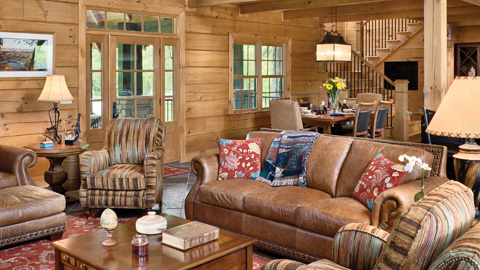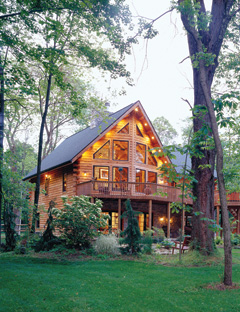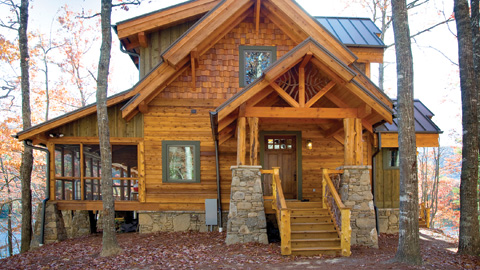Choosing a log and timber home is the first step down the path toward eco-friendly living. Wood is a renewable resource. Sustainability is a key component, and while the choice of a primary building material is an excellent starting point it opens the door to an enhanced environmental awareness and lifestyle.
“Keep life cycle in mind,” explains Josh Beasley, president of Honest Abe Log Homes, Inc. “Log and timber homes are naturally eco-friendly, which to many may sound absurd on the surface. However, when the environmental impact of the life cycle of a product is taken into account it changes the conversation. Man-made materials like fiberglass insulation, sheetrock, and synthetic siding all take a considerable amount of energy to produce. They can diffuse toxins throughout their use and can make a significant ecological impact at the end of their life cycles.
“Wood is natural,” Beasley continues, “and as it grows, carbon is removed from the atmosphere, providing positive ecological effects. The harvesting of a tree for a log home allows for the planting or natural growth of another, and that cycle of life is at its very nature eco-friendly.”
Throughout the construction process, from blueprints and site preparation to moving in, the eco-friendly theme of log and timber home building is carried along. “There are choices and methods that can be used in building a new home that help facilitate the eco-friendly lifestyle,” expands Robert Lambert, founder and president of Natural Element Homes. “Some examples are to build an energy-efficient home that utilizes energy-efficient mechanical systems and products such as lighting, HVAC systems, water systems, waste systems, and insulation systems.”

Photo by Roger Wade
“Use quality insulation and sealing methods,” Lambert adds, “high-efficiency HVAC, dual-flush toilets, tankless hot water heaters, water-saving faucets, and highly efficient windows and doors. You can also employ methods to properly seal the home from air leakage, include recycle bins, water capture and recycling systems, and recycled building materials.”
Lambert says that SIP panels provide an excellent option for insulation efficiency, while hybrid homes benefit from adding two inches of spray foam insulation to studwalls before installing fiberglass BAT (Flash and Batt) insulation. The Huber ZIP-R system is another alternative that adds up to an inch of Polyiso insulation between the studs and outer sheathing to reduce thermal bridging.
Before construction even begins, positioning the log & timber home properly on the lot can make a big difference when it comes to energy efficiency. “Site positioning is one of the most affordable yet often overlooked steps,” comments Beasley, “allowing homeowners to take advantage of, or limit, solar heat gain. Thankfully, with log and timber homes we are rarely conforming to tiny lots within a subdivision where positioning our home the way we want it isn’t an option. So do a little research and talk with your builder about your home design, the attributes of your building site, and how these might work together.”
 Although conventional fink trusses are still common in practical home designs, a smart choice might be including raised heel or energy trusses in the framing. These trusses are elevated with a heel that sits on top of the wall, allowing for additional insulation. Traditional trusses do not. Josh Watson, construction and operations manager at Honest Abe Log Homes, notes that energy trusses actually provide space for fully insulating the area between the wall and the roof through an extension of the “feet” on the truss to a height that allows a much higher R-value.
Although conventional fink trusses are still common in practical home designs, a smart choice might be including raised heel or energy trusses in the framing. These trusses are elevated with a heel that sits on top of the wall, allowing for additional insulation. Traditional trusses do not. Josh Watson, construction and operations manager at Honest Abe Log Homes, notes that energy trusses actually provide space for fully insulating the area between the wall and the roof through an extension of the “feet” on the truss to a height that allows a much higher R-value.
Windows are often a real aesthetic plus in log and timber homes. However, energy efficiency is the watchword when really enjoying a stunning view. “With glass being the theme of not only gable ends but structures as a whole, choosing an Energy Star®-rated window is imperative to the efficiency of your house,” says Watson.
Lambert agrees. “Obtaining Energy Star® certification is not complicated and does not add much to construction costs these days. Any added costs can be quickly recouped with lower energy bills.”
While cost is definitely a factor in eco-friendly construction, the immediate investment can reap long-term benefits that make a few extra dollars on the front end well worth it. For example, Flash and Batt insulation will usually add about $1 per square foot of wall or roof surface area, but it will significantly reduce energy consumption with a payback that is realized in a relatively short time.
“In the realm of eco-friendly construction, options range from very practical with little to no added up-front cost to the absurdly expensive and unusual,” advises Beasley. “We find that the majority of our clients like to start out simple and work their way up until they reach a comfort level between good stewardship, initial budget constraints, and their return on investment. I believe it is common knowledge now that a number of eco-friendly or green measures can be taken with weighted costs and promises of a return on investment over a certain period. Do research on any product promising a return on investment over time. Read reviews from other homeowners and talk with your contractor about these products.”
Building an eco-friendly log or timber home starts with research, evolves into site planning, construction, and finishing, and continues perpetually as a committed lifestyle. Realizing the results of a responsible perspective makes an extra eco-friendly effort more than worthwhile.

